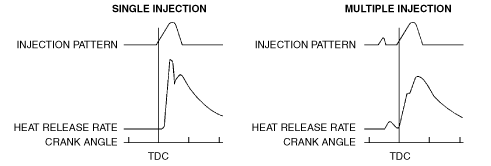MULTIPLE FUEL INJECTION CONTROL [SKYACTIV-D 1.5]
id0140z5988100
Outline
• Multiple fuel injection control has been adopted in which the number of fuel injections is divided over several times for the purpose of noise and NOx reduction.
-
― For single injection, a greater amount of fuel is consumed to inject the necessary amount of fuel at one time. For this reason, the fuel is combusted rapidly at a high temperature and high pressure, resulting in increased noise and NOx.
― In multiple injection, combustion is performed more slowly to divide the necessary fuel amount over several times, thus controlling noise and the occurrence of NOx.
• The PCM injects fuel several times prior to the main injection according to the vehicle operation conditions. (Pilot injection)
• During fast heating control and DPF regeneration control, fuel is injected after the main injection to increase the exhaust gas temperature. (Follow-up injection, post injection)
Block Diagram
Operation
• The PCM determines the number of fuel injections based on the fuel injection amount and signals from each sensor.
• When the engine is started, the number of fuel injections is determined by the engine coolant temperature and the engine speed.
• In the multiple fuel injection control, there are various patterns from the combination of the number of fuel injections.
• The PCM selects the optimum pattern based on the vehicle conditions and performs fuel injection for a maximum of 8 times.
|
Control range
|
Control description
|
|
Normal injection
|
Low engine speed, low load
|
For the purpose of reducing engine knock occurring during combustion and to assure ignitability, the number of fuel injections is increased to a maximum of 5 times.
|
|
High engine speed, high load
|
Output and fuel consumption is improved by reducing the fuel injection time and injecting a higher amount of fuel over a fewer number of injections.
|
|
FAST HEATING CONTROL
|
When the engine coolant temperature is low and the cabin heating performance is insufficient, 2 additional follow-up injections are performed to increase the exhaust temperature from the after-burn.
|
|
DPF regeneration control
|
During DPF regeneration, fuel injection is performed at a slower timing than normal to remove particulate matter (PM) accumulated in the diesel particulate filter.
1. Follow-up injection is performed after the main injection. (increases exhaust pipe temperature)
2. Post injection is performed 1—5 times* (increases exhaust temperature necessary for combustion and removal of particulate matter (PM))
|
|
Fuel-cut
|
During fuel-cut operation, fuel is not injected by the fuel injection amount control.
|
* :When the unburned fuel (HC) caused by the post injections reaches the oxidation catalytic converter, it is activated at the catalyst, and the exhaust gas temperature is increased. The division of the post injection into 1—5 times is for the purposes of reducing engine oil dilution and fuel adhesion to the cylinder walls. If fuel injection is performed at a slower timing than normal (timing in which no combustion occurs in cylinder), the fuel flows to the oil pan, and there is the possibility of the engine oil becoming diluted. In addition, by injecting small amounts of fuel in multiple stages, the penetration power of the atomized fuel is reduced and adhesion of fuel to the cylinder wall is prevented.
Regarding engine oil dilution from post injection
-
• Although post injection, in which fuel injection occurs after the combustion process, is effective for DPF regeneration control by after-burn, fuel adhesion to the inside of the cylinder wall occurs with the possibility of engine oil dilution.
• As for the symptoms of engine oil dilution, use the guidelines indicated in the table below. (The engine oil level changes dramatically depending on the oil temperature and the amount of time elapsed since the engine was turned off, thus there may be differences in the actual engine oil level.)
—: Not applicable
|
Item
|
Engine oil dilution
|
|
Engine oil dilution amount reference
|
 |
|
Oil level gauge position
|
A
|
B
|
C
|
|
Engine oil warning light
|
No problem
|
Illuminated
|
|
Wrench indicator light
|
—
|
Illuminated*1
|
|
DTC recorded in PCM
|
P253F:00
|
P252F:00*1, P253F:00
|
|
DPF regeneration control range (auto DPF regeneration control)
|
DPF regeneration control range (auto DPF regeneration control)
|
|
User action
|
Vehicle servicing at Authorized Mazda Dealer
|
Vehicle servicing at Authorized Mazda Dealer
|
|
Engine oil data reset after engine oil replacement
|
|
Action taken by servicing at Authorized Mazda Dealer
|
Action A
|
Action B
|
*1 :With engine oil level sensor
-
Action A
-
• If DTC P253F:00 is stored in the PCM, replace the engine oil and reset the engine oil data using the Mazda Modular Diagnostic System (M-MDS) even if the engine oil level is lower than the X mark on the oil level gauge.
-
Action B
-
• After verifying the engine oil level, replace the engine oil and implement the engine oil data reset using the Mazda Modular Diagnostic System (M-MDS).

